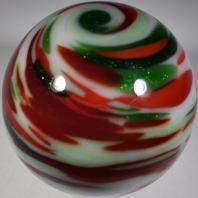-
Posts
670 -
Joined
-
Last visited
-
Days Won
1
Content Type
Profiles
Forums
Gallery
Events
Everything posted by Shamrock Marbles
-
Corks have a twist. When looking at a end, the twist will either be Left-handed or Right-handed like the threads on a screw. Right-hand twist: Left-hand The ratio is how many RH to LH marbles you have. Your first photo group of 17 marbles, your RH:LH ratio is: 6:11.
-
Sweet specimens! Have you noted the RH to LH twist ratio?
-

Ta-Da!! My first Ameba!!
Shamrock Marbles replied to treetiger's topic in General Marble & Glass Chat
Exciting!! Keep it up. A simple suggestion: 1) Make 100 marbles. 2) Number them sequentially (e.g. 001, 002, 003,…). 3) Put them in gun cases or fishing lure boxes in numerical order. 4) Keep them all for reference. 5) Get a notebook. Make a page for each marble. Describe what you wanted as a finished design. Note the glass colors used. Described the finished marble. Write down what you learned or would do differently. Grading is optional. Don't worry about each marble and enjoy the journey. By the time you make 100 marbles, you’ll be amazed how far you have come from your first ten. Please, keep posting your babies. -John -
Sweet selection. Superb effort on the photos. 👍🏻
-

Should I start a new Mortgage?
Shamrock Marbles replied to akroorka's topic in General Marble & Glass Chat
YOLO. If this is your jam, then go for it. If you are a Peltier collector, why not stretch for something special. Eat beans and rice for a year. You’ll still enjoy the marbles even after the sacrifice. -
Lovely. Funny, that Gerry didn’t need to sign these. Pretty much you knew who made it by looking at it. I always wondered if he made his millefiori cane or bought from Moretti. Back in the day, Gerry made a VHS of how to make marbles. I think I have a copy buried somewhere. I don’t think he covered how these particular marbles were constructed. True pocket art that will need to be rediscovered by another generation. Kind of like Bill Murray (Cape Cod Glass) marbles. Thanks for sharing.
-
Gerry Colman? Did you buy these artist direct or through another channel? The Polar end shots are great, but the side views tell the whole story. Lovely photos as usual. Thank you.
-

Scott Patrick's Kingly Line?
Shamrock Marbles replied to Steph's topic in General Marble & Glass Chat
LOL! You don't speak ill of the dead, but here you state that Scott threatened you. Shame he can't defend himself. You just fell off your high horse. Oh, by the way, Scott threatened many people over the years. You aren't that special. *** Over the past 20 years on the boards, I can't recall one informative post from you that talks about how to identify real or reproduction marbles or medals. When doing your posts, I notice how you don't elaborate on any backstory or your possible connection/involvement. You have a lot of knowledge, let it flow... *** Let's fly back to March 2005. You visited the KC Marble Crazy show still hot and bothered by the CA "Exotics" on Baumann's latest book. You were adamant these were fakes. You saw me demonstrate my "Genesis" marble machine at Moon Marble. You asked lots of questions. I gave lots of answers. You even bought marbles from me. You really liked digging through my $1 box. You saw Chris Robinson's refurbished machine that he made his Road & Tunnel marbles on. You watched Chris demo a marble at the glory hole. You talked with other artists. But you had a motive. Do you remember that motive? Do you wish to share your "plan"? I can vividly remember my anger at you. I made it clear that I was not going to be complicit with your activity nor be a quiet spectator. About a year or so later, you came to my room at the Columbus Show to look at the collaboration marbles Chris and I did at his shop. You went right for the Christmas Tree marble. Good eye. Well, with that out. What have you been up to? -

Scott Patrick's Kingly Line?
Shamrock Marbles replied to Steph's topic in General Marble & Glass Chat
Alan is spot on. If one was to research what a sociopath is - Scott Patrick was the poster child. Scott reveled in pointing out the ignorance of the base collector society. Don’t forget that Scott had superior skills. The shame was not preventing people from being duped, but he enjoyed watching collectors tripped up in their poor judgment. Now, there were a few contemporary “collaborators” that supported and encouraged Scott with his peripheral behavior. These (This) person(s) would like to rewrite their past behavior. Sociopathy can be found in all societal segments. Marbles are no exception. Be warned on all posts. -

Favorite Ugly marble you love !
Shamrock Marbles replied to Fire1981's topic in General Marble & Glass Chat
Indented trunnion! Sweet!! -
An interesting article: Carnival Glass World Wide Article
-
I may be mistaken, but that purple (?) is the base glass. I think the white glass is the veneer. Would love to know other people’s opinions.
-
Would love to look at those up close. At 35k feet, it looks like a compatibility issue. In a sphere, the distance from the center to any surface is basically equal. What causes asymmetrical stress is usually an internal aberration (think refractory or an air bubble). In many CA Guinea fragments, you can see fracture planes emanating from an internal air bubble.
-

Slags & Swirls Saturday!!
Shamrock Marbles replied to William's topic in General Marble & Glass Chat
A top color combination for a CAC flame! Congrats and enjoy! -
Happy Birthday!! There is something very special about getting a gift from a loved one. It becomes extremely special when what they gift you shows that they have taken care to listen and deliver the unexpected. Birthday blessings!! -John
-
There are some large marbles shown in Stephan Bahr’s video:
-
The seller is a well known marble collector/dealer. There are probably very few with more knowledge about Peltier marbles and the off-shoot Kokomo varieties. He is also a good educator. If you were to reach out and ask, he would be very helpful. Sweet marble.
-
Here’s a post from a few years ago and a nice explanation from Royal: https://marbleconnection.com/topic/23099-jabos/#comment-207925
-
Very, very nice. Thanks for sharing! -John
-
It looks like the letters are raised on the glass surface. If so, then the text was stamped/engraved into the mold. Someone used a regular stamp set instead of a reverse stamp set. Can’t imagine this item brought big money at the Five-and-Dime. So, no real loss. Was probably fixed when the mold was worn or damaged. I’ve seen guys stamp all kinds of stuff on serial plates. You have to visualize it in reverse. Just imagine an engraver for the US Mint! Everything is flipped!
-
Sweet marbles. Just proves you don’t need to spend a ton of money to get some enjoyment. Also, you can DIY frosted marbles with this: Just follow all safety precautions. -John
-

Slags & Swirls Saturday!!
Shamrock Marbles replied to William's topic in General Marble & Glass Chat
That air pocket blow out is just astonishing. There is no way that that marble has been polished. Beautiful pattern. -John -

Slags & Swirls Saturday!!
Shamrock Marbles replied to William's topic in General Marble & Glass Chat
Great glass combo. Very few are better. Just lovely. -

Slags & Swirls Saturday!!
Shamrock Marbles replied to William's topic in General Marble & Glass Chat
Light me up!! Lovely. 💕 -

Marble Themed Pinball Machine
Shamrock Marbles replied to Shamrock Marbles's topic in General Marble & Glass Chat
When in college, every pinball machine in the city was 25-cents. At the UC, a game was 10-cents. Add that the board angle was shallow and the bump sensitivity was reduced, you could hip-bump those machines around and never drain a ball. It took hours to go through $1. Fun times!









